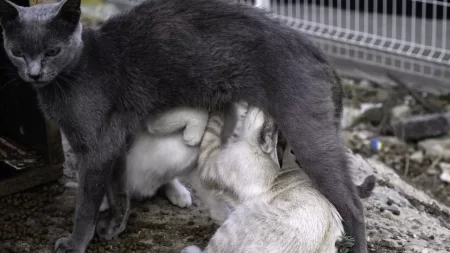Allergies may make pets miserable. Understanding the reasons and symptoms is essential to helping our feline buddies.
This blog post discusses cat allergies, common allergens, and treatment alternatives.
Learn about cat food and environmental allergens to keep your cat healthy.
Understanding Cat Allergies
Allergies are immunological responses to innocuous allergens. Food, pollen, dust mites, mildew, and dander may cause cat allergies. Cats with food and environmental allergies may be hard to diagnose.
Difference between environmental and food-related allergies
Environmental allergies cause inflammation in cats. If the cat’s skin barrier is broken, environmental allergens may infiltrate and cause an immunological response. The allergen and its availability determine whether environmental allergies are seasonal or year-round.
Food allergies in cats are immune system reactions to protein sources including beef, fish, poultry, or dairy. A cat might get allergic to a meal it has consumed for a long period after being introduced to it. Food allergies are rare yet dangerous.
Symptoms of Cat Allergies
The main symptom of both food and environmental allergies in cats is itching and skin inflammation. This may present itself as:
- Persistent scratching and rubbing, especially around the head and neck
- Excessive licking, chewing, or biting
- Redness or a rash
- Hair loss
- Skin and ear infections
- Darkened skin
These symptoms might induce cat pain and subsequent bacterial and yeast infections. Scratching and biting may lead to open wounds and problems.
Food-allergic cats may vomit or have diarrhea. Scooting may result from rectum irritation. They may strain or have frequent bowel motions.
Common causes of environmental allergies in cats
Environmental allergens can be found inside and outside the home. Some of the most common ones are:
- Pollen from grasses, weeds, trees, or flowers
- Mold spores from damp areas or decaying organic matter
- Dust mites from carpets, bedding, furniture, or curtains
- Dander from other animals or humans
- Fleas or flea saliva
Some cats may be allergic to more than one environmental allergen, which can make their symptoms worse.
Common causes of food allergies in cats
Food allergies are caused by specific proteins in the cat’s diet. The most common ones are:
- Beef
- Fish
- Chicken
- Dairy
- Eggs
- Soy
- Wheat
- Corn
Some cats may be allergic to more than one food ingredient, which can make their symptoms worse.
Is There a Link Between Cat Food and Environmental Allergies?
Environmental allergies and cat food are unknown. Some research imply a link between food and environmental allergies.
Some dietary additives may decrease the skin barrier function and increase environmental allergy sensitivity. Some cats’ diets may lack critical fatty acids, which may compromise skin hydration and inflammation. Some foods may cause gut inflammation that impairs the immune system.
Cats may cross-react to dietary and environmental allergies. Their immune system responds to comparable proteins in diet and environment as dangerous. Due to their similar protein structures, some cats are sensitive to fish and dust mites.
These processes are unclear and may not apply to all allergic cats. In certain circumstances, food may help manage environmental allergies.
Managing Cat Allergies
Identifying and eliminating the allergen that causes cat allergies is ideal. The overlap between food and environmental allergy symptoms and the difficulties of identifying the allergen makes this problematic. Thus, a vet should identify and treat cat allergies.
Identifying and eliminating environmental allergens
First, rule out parasites, infections, and hormone abnormalities as reasons of itching and skin issues. To establish the reason, the veterinarian may undertake a physical exam, skin scrapings, blood testing, or other diagnostic procedures.
The veterinarian may offer a blood or intradermal skin test to determine the cat’s allergens if environmental allergies are suspected. These tests measure the cat’s immunological response to modest quantities of allergens.
Once the allergens are identified, the next step is to eliminate or reduce exposure to them as much as possible. This may involve:
- Keeping the cat indoors during peak pollen seasons
- Using air filters, humidifiers, or dehumidifiers to improve indoor air quality
- Vacuuming and dusting regularly to remove dust mites and dander
- Washing bedding and toys frequently in hot water to kill dust mites
- Using hypoallergenic or dust mite-proof covers for mattresses and pillows
- Avoiding contact with other animals or humans that may carry dander or fleas
- Using flea prevention products regularly to prevent flea infestations
Dietary changes for cats with food allergies
The veterinarian may suggest an elimination diet experiment to identify the allergen if food allergies are suspected. This entails giving the cat a diet without any proteins it has been exposed to for eight weeks. This may be a veterinary-supervised homemade or commercial hypoallergenic diet.
The cat should only consume the specified diet, including treats, vitamins, and human food, throughout the study. If the diet works, the cat should feel better in weeks. The veterinarian may reintroduce the original food or substances to confirm the diagnosis.
After identifying the food allergy, stop giving it to the cat. Read labels and choose foods without allergens or cross-contaminants. Some cats may benefit from a new or hydrolyzed protein diet that comprises proteins that are unlikely to produce an allergic reaction or are broken down into smaller pieces that are less likely to generate an immunological response.
Consulting a veterinarian for proper diagnosis and treatment
Cat allergy allergens may be difficult to eradicate. The veterinarian may recommend drugs or supplements to manage symptoms and avoid problems. Such as:
- Antihistamines to reduce itching and inflammation
- Corticosteroids suppress the immune system and reduce inflammation
- Cyclosporine to modulate the immune system and reduce inflammation
- Oclacitinib or lokivetmab to block specific enzymes or antibodies involved in allergic reactions
- Omega-3 fatty acids support skin health and reduce inflammation
- Antibiotics or antifungals to treat secondary infections
Immunotherapy, which gradually injects allergens to desensitize the immune system, may help certain cats. Some cats with environmental allergies might benefit from this lengthy and expensive therapy.
Conclusion
Food and environmental allergies may cause itching and skin issues in cats. They have similar symptoms and origins, but their diagnosis and treatment are different. Diet may impact environmental allergies, but cat food has not been shown to cause them. Cat allergies are best managed by working with a veterinarian to identify and eradicate the allergen or by using drugs or supplements to reduce symptoms.







